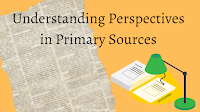
06 May Understanding Perspectives in Primary Sources – A New National Archives Resource
Once they understood the difference between a primary and secondary source, helping students understand the context, meaning, and purpose of primary source documents was one of the things that I enjoyed the most when I taught U.S. History. To that end, I often used resources from the National Archives Daily Document RSS feed to spark conversations in my classroom. The National Archives recently published a new guide to help students understand perspectives in primary sources.
Once they understood the difference between a primary and secondary source, helping students understand the context, meaning, and purpose of primary source documents was one of the things that I enjoyed the most when I taught U.S. History. To that end, I often used resources from the National Archives Daily Document RSS feed to spark conversations in my classroom. The National Archives recently published a new guide to help students understand perspectives in primary sources. Understanding Perspectives in Primary Sources (link opens a PDF) is a free guide that you can download and distribute to your students. The guide leads students through a series of questions designed to help them identify the type of primary source (writing, drawing, audio recording, etc.), who created it, and the context in which it was created (time, place). Applications for EducationOne of the most important aspects of the Understanding Perspectives in Primary Sources guide is in the last section. In that section students are asked, “what evidences does the creator present that you should fact check?” This is important because, in my experience, a lot of students assume that just because something is an old primary source it is therefore infallible as a source of information. The question that I would always ask my students to consider was, “does what you’re reading line up with what you already know about this topic?” Are you a tech coach or media specialist looking for some new ideas to share with your colleagues? If so, 50 Tech Tuesday Tips is an eBook you need. You can get it right here. Free History Lesson Plans, Free Technology For Teachers, History, National Archives, primary sources, Social Studies, teaching with primary sources, U.S. HistoryRead More
Free History Lesson Plans, Free Technology For Teachers, History, National Archives, primary sources, Social Studies, teaching with primary sources, U.S. HistoryRead More


Sorry, the comment form is closed at this time.